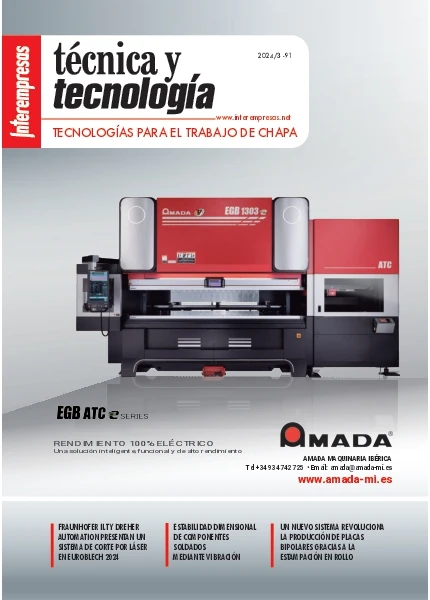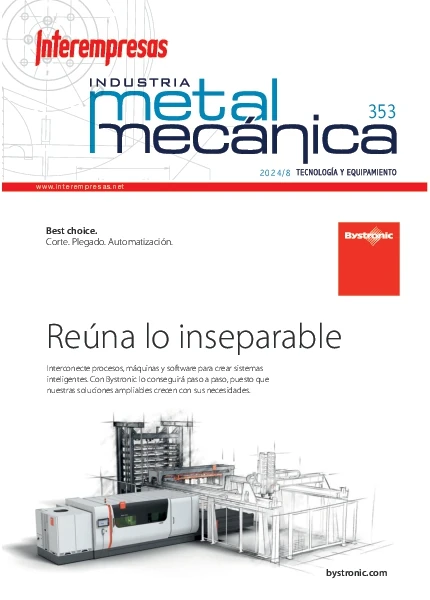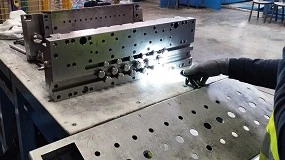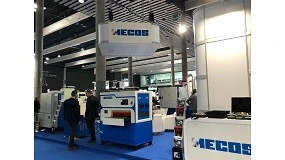Agriculture under plastic in Spain
July 21, 2009
History
The idea of growing plants in a climate-controlled environment goes back to Roman times. It seems that Emperor Tiberius doctors advised him to eat a cucumber on the day and their gardeners developed a method of growing to do so to get to your table every day of the year. The plants were placed under structures covered with fabric impregnated with oil, known as "specularia" or sheets of mica.
The first modern greenhouses, covered with glass, were built in Italy in the 13th century to House exotic plants that explorers brought from the tropics. The experiment quickly spread to Holland and England, along with plants. These early attempts required a lot of work to
close them at night or during the winter and they had serious difficulties to maintain an appropriate heat level. With the development of the Botanical Science, the greenhouses became universities. In England sometimes referred to as 'conservatories' greenhouses, because they served to preserve the plants. The French called the first greenhouses 'orangeries', because they protected the naranjos of frost.
Experimentation with the design of greenhouses continued during the 17TH century, while there were increasingly better qualities of glass and advanced construction techniques. The greenhouse of the Palace of Versailles is a good example of this era.
Older glass greenhouses were built in the 19th century. The greenhouse of the Kew Gardens in England is an example of Victorian greenhouse, which would also include the Crystal Palace in London, the Crystal Palace in New York and the Glaspalast in Munich.
In the 20th century economic development led, especially after the second world war, the construction of glass greenhouses. Netherlands surpassed the five thousand hectares in the middle of the 20th century especially dedicated to the cultivation of tomato.
The use of plastic materials such as greenhouse covers is relatively recent. Started in 1948 in the us with prof. e. M. Emmert of the University of Kentucky, who had the idea to replace the glass with regenerated cellulose (paper cellophane) to cover a wooden structure. Since then plastic greenhouses have been extended by the five continents and have displaced glass as a material of walls.
In Spain the first plastic greenhouses were installed in 1958 in the Canary Islands and not spread to the Iberian peninsula until 1965. The invernada surface growth has been continuous since then.
Surface
If we consider the entire surface of the Earth, the greenhouses are concentrated in two areas: in the far East (especially China, Japan and Korea) is grouped 80% of the greenhouses in the world and in the Mediterranean basin about 15% (Figure 1). Growth is slow in Europe, but in Africa and Middle East is still 15 to 20 per cent per annum. Notably China, which has gone to 4,200 hectares in 1981 to 1,250,000 hectares in 2002 (30% per year). Excluding China, the global area of greenhouses can be estimated 350,000 hectares.
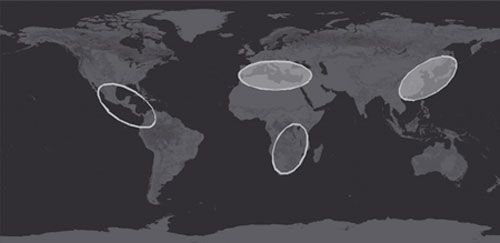
In the Mediterranean basin (Figure 2) highlights the surfaces covered in Spain and Italy, although in the latter country figures vary greatly depending on the sources consulted. The countries that are growing most are Morocco and Turkey, while others such as France are in recession.
Within Spain greenhouses are concentrated in the autonomous communities of Andalusia, where Almería has the largest concentration of greenhouses in the world, Murcia and the Canary Islands.

Crops
Of the total area under greenhouse in Spain, 53,800 hectares (ha), 88 per cent is dedicated to the cultivation of vegetables (tomato, pepper, cucumber, green bean, strawberry, melon, watermelon, eggplant, Zucchini and lettuce, in descending order of importance). The production of ornamental plants and flowers (mainly clavel y rosa) occupies 5% of the covered area. The banana is the main tree growing under plastic and occupies the rest of the area.
According to figures from the Ministry of agriculture, fisheries and food, the main crops in greenhouse in Spain are those listed in table 1. Note that the total surface of all crops is higher than the surface of greenhouses in Spain. This is because in many greenhouses are two and even three cycles of crops per year, generally combining crops of winter (tomato, pepper, etc.) with other spring (melon, watermelon, etc.).
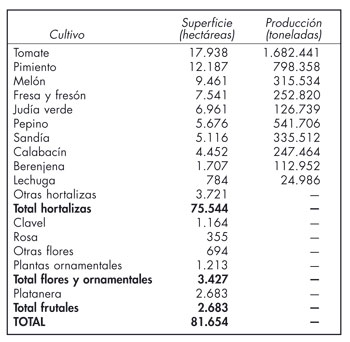
Economic importance
The production of vegetables and flowers had increased in recent decades thanks to agriculture under plastic. A good example is the province of Almeria, where intensive farming techniques have contributed to a significant improvement of the local economic level, as shown in the income per capita, which happened to be the second lowest in 1970for the fifth seat. While in 1975 the Almeria agriculture invoiced 9.5 billion pesetas (57 million euros), in the 2006-2007 campaign was reached 1.443 million of euros.
In this final campaign production amounted to 2.841 million tonnes, of which 1,512 million tonnes were exported. 96% Of these exports had as destination the European Union, most notably Germany (26.6%), France (18.2%), Holland (14.7%) and United Kingdom (11%). The sector employs directly 45.100 people in the province of Almería (number of workers affiliated to the agricultural special scheme of Social Security), of which 21.300 are foreign.


